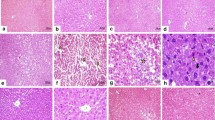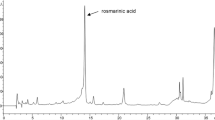Abstract
The present study was designed to evaluate the hepatoprotective effects of newly isolated stigmast-4, 20 (21), 23-trien-3-one (STO) against carbon tetrachloride-induced hepatic injury in Wistar albino rats. Hepatotoxicity was induced by the administration of a single intraperitoneal dose of CCl4 (0.5 mL/kg CCl4 in olive oil) in experimental rats. Three different doses (2.5, 5.0, and 10 mg/kg, p.o) of STO was administered to the test groups during whole experimental protocol. Changes in the activity of serum ALT, AST, ALP, TB, and TP, anti-oxidant enzymes like SOD, CAT, GPx, GST, and LPO were studied in CCl4-induced hepatocellular carcinogenesis. The altered levels of serum ALT, AST, ALP, TB, and TP restored toward normalization significantly by STO in a dose dependant manner. The biochemical observations were supplemented with histopathological examination of rat liver sections. Meanwhile, it also produced a significant and dose-dependent reversal of CCl4-diminished activity of anti-oxidant enzymes like SOD, CAT, GPx, GST, and the reduced CCl4-elevated level of LPO. STO significantly prevented the increased levels of serum markers, also suppressed the free radical processes by scavenging hydroxyl radicals. It also modulates the levels of LPO and markedly increases the endogenous anti-oxidant enzymes level in CCl4-induced hepatic injury.


Similar content being viewed by others
References
Karakus E, Karadeniz A, Simsek N, Can I, Kara A, Yildirim S (2011) Protective effect of Panax ginseng against serum biochemical changes and apoptosis in liver of rats treated with carbon tetrachloride (CCl4). J Hazard Mater 195:208–213
Cemek M, Aymelek F, Buyukokuroglu ME, Karaca T, Buyukben A, Yilmaz F (2010) Protective potential of royal jelly against carbon tetrachloride induced toxicity and changes in the serum sialic acid levels. Food Chem Toxicol 48:2827–2832
Papay JI, Clines D, Rafi R, Yuen N, Britt SD, Walsh JS, Hunt CM (2009) Drug-induced liver injury following positive drug rechallenge. Regul Toxicol Pharmacol 54:84–90
Stuver S, Trichopoulos D (2008) Cancer of the liver and biliary tract. In: Adami HO, Hunter D, Trichopolous D (eds) Textbook of cancer epidemiology, 2nd edn. Oxford university press, New York, pp 308–332
Wang T, Sun NL, Zhang WD, Li HL, Lu GC, Yuan BJ (2008) Protective effects of dehydrocavidine on carbon tetrachloride-induced acute hepatotoxicity in rats. J Ethnopharmacol 117:300–308
Larson AM, Polson J, Fontana RJ, Davern TJ, Lalani E, Hynan LS, Acute Liver Failure Study Group (2005) Acetaminophen-induced acute liver failure: results of a United States multicenter, prospective study. Hepatology 42:1364–1372
Domenicali M, Caraceni P, Giannone F, Baldassarre M, Lucchetti G, Quarta C (2009) A novel model of CCl4-induced cirrhosis with ascites in the mouse. J Hepatol 51:991–999
Tian LM, Shi XL, Yu LH, Zhu J, Ma R, Yang XB (2012) Chemical composition and hepatoprotective effects of polyphenol-rich extract from Houttuynia cordata tea. J Agric Food Chem 60:4641–4648
Lee CH, Park SW, Kim YS, Kang SS, Kim JA, Lee SH, Lee SM (2007) Protective mechanism of glycyrrhizin on acute live injury induced by carbon tetrachloride in mice. Biol Pharm Bull 30:1898–1904
Gopal N, Sengottuvelu S (2008) Hepatoprotective activity of Clerodendrum inerme against CCl4 induced hepatic injury in rats. Fitoterapia 79:24–26
Sanmugapriya E, Venkataraman S (2006) Studies on hepatoprotective and antioxidant actions of Strychnos potatorum Linn. seeds on CCl4-induced acute hepatic injury in experimental rats. J Ethnopharmacol 105:154–160
Yang X, Yang S, Guo Y, Jiao Y, Zhao Y (2013) Compositional characterisation of soluble apple polysaccharides, and their antioxidant and hepatoprotective effects on acute CCl4-caused liver damage in mice. Food Chem 138:1256–1264
Shen X, Tang Y, Yang R, Yu L, Fang T, Duan JA (2009) The protective effect of Zizyphus jujube fruit on carbon tetrachloride-induced hepatic injury in mice by anti-oxidative activities. J Ethnopharmacol 122:555–560
Recknagel RO, Glende EA (1973) Carbon tetrachloride hepatotoxicity: an example of lethal cleavage. CRC Crit Rev Toxicol 2:263–297
Hung MY, Fu TY, Shih PH, Lee CP, Yen GC (2006) Du-Zhong (Eucommia ulmoides Oliv.) leaves inhibits CCl4-induced hepatic damage in rats. Food Chem Toxicol 44:1424–1431
Afzal M, Gupta G, Kazmi I, Rahman M, Afzal O, Alam J, Hakeem KR, Pravez M, Gupta R, Anwar F (2012) Anti-inflammatory and analgesic potential of a novel steroidal derivative from Bryophyllum pinnatum. Fitoterapia 83(5):853–858
Mathurin P, Mendenhall CL, Carithers RL (2002) Corticosteroids improve short-term survival in patients with severe alcoholic hepatitis (AH): Individual data analysis of the last three ran-domized placebo controlled double blind trials of corticosteroids in severe AH. J Hepatol 36:480–487
Mihailovic V, Mihailovic M, Uskokovic A, Arambasic J, Misic D, Stankovic V, Katanic J, Mladenovic M, Solujic S, Matic S (2013) Hepatoprotective effects of Gentiana asclepiadea L. extracts against carbon tetrachloride induced liver injury in rats. Food Chem Toxicol 52:83–90
Kotoh K, Enjoji M, Nakamuta M, Yoshimoto T, Kohjima M, Morizono S, Yamashita S, Horikawa Y, Yoshimitsu K, Tajima T, Asayama Y, Ishigami K, Hirakawa M (2006) Arterial steroid injection therapy can inhibit the progression of severe acute hepatic failure toward fulminant liver failure. World J Gastroenterol 12:6678–6682
Clawson GA (1989) Mechanism of carbon tetrachloride hepatotoxicity. Pathol Immunopathol Res 8:104–112
Rao PGM, Rao SG, Kumar V (1993) Effect of Hepatogard against carbon tetrachloride induced liver damage in rats. Fitoterapia 64:108–113
Yadav NP, Dixit VK (2003) Hepatoprotective activity of leaves of Kalanchoe pinnata Pers. J Ethnopharmacol 86:197–202
Mi LJ, Mak KM, Lieber CS (2000) Attenuation of alcohol induced apoptosis of hepatocytes in livers by polyenylphosphatidylcholine (PPC) alcohol. Clin Exp Res 24:207–212
Al-Shabanah OA, Alam K, Nagi MN, Al-Rikabi AC, Al-Bekairi AM (2000) Protective effect of aminoguanidine, a nitric oxides synthase inhibitor, against carbon tetrachloride induced hepatotoxicity in mice. Life Sci 66:265–270
Naziroglu M, Cay M, Ustundag B, Aksakal M, Yekeler H (1999) Protective effects of vitamin E on carbon tetrachloride-induced liver damage in rats. Cell Biochem Funct 17:253–259
Tirkey N, Pilkhwal S, Kuhad A, Chopra K (2005) Hesperidin, A citrus bioflavonoid, decreases the oxidative stress produced by carbon tetrachloride in rat liver and kidney. BMC Pharmacol 5:1–8
Liu GT, Li Y, Wei HL, Zhang H, Xu JY, Yu LH (2005) Mechanism of protective action of bicyclol against CCl4-induced liver injury in mice. Liver Int 25:872–879
Amin A, Hamza AA (2005) Oxidative stress mediates drug-induced hepatotoxicity in rats: a possible role of DNA fragmentation. Toxicology 208:367–375
Drotman RB, Lawhorn GT (1978) Serum enzymes are indicators of chemical induced liver damage. Drug Chem Toxicol 1:163–171
Cherubini A, Ruggiero C, Polidori MC (2005) Potential markers of oxidative stress in stroke. Free Radic Biol Med 39:841–852
Lykkesfeldt J (2007) Malondialdehyde as biomarker of oxidative damage to lipids caused by smoking. Clin Chim Acta 380:50–58
Hietanen E, Ahotupa M, Bartsch H (1987) Lipid peroxidation and chemically induced cancer in rats fed lipid rich diet. In: Lapis K, Kcharst S (eds) Carcinogensis and tumor progression, vol 4. Akademiaikiado, Budapest, pp 9–16
Klaunig JE, Kamendulis LM (2004) The role of oxidative stress in carcinogenesis. Ann Rev Pharmacol Toxicol 44:239–267
Szymonok-Lesiuk S, Czechowska G, Stryjecka-Zimmer M, Stomka M, Madro A, Celinski K, Wielosz M (2003) Catalase, superoxide dismutase, and glutathione peroxidase activities in various rat tissues after carbon tetrachloride intoxication. J Hepatobiliary Pancreat Surg 10:309–315
Hayes JD, Flanagan JU, Jowsey IR (2005) Glutathione transferases. Ann Rev Pharmacol Toxicol 45:51–88
Wu G, Fang YZ, Yang S, Lupton JR, Turner ND (2004) Glutathione metabolism and its implications for health. J Nutr 134:489–492
Zindenberg CS, Olin KL, Villarweva J (1991) Ethanol induced changes in hepatic free radical defense mechanisms and fatty acid composition in the miniature pig. Hepatology 13:1185
Pena LR, Hill DB, Mc Clain CJ (1999) Treatment with glutathione precursor decreases cytokine activity. JPEN J Parenter Enteral Nutr 23:1–6
Teocharis SE, Margelo AP, Skaltsas SD, Spiliopoulou CA, Koutselinis AS (2001) Induction of metallothionein in the liver of carbon tetrachloride intoxicated rats: an immunohistochemical study. Toxicology 161:129–138
Lu YY, Wang CP, Zhou L, Chen Y, Su SH, Feng YY, Yang YP (2008) Synthesis of platelet-activating factor and its receptor expression in Kupffer cells in rat carbon tetrachloride-induced cirrhosis. World J Gastroenterol 14:764–770
Author information
Authors and Affiliations
Corresponding authors
Rights and permissions
About this article
Cite this article
Afzal, M., Khan, R., Kazmi, I. et al. Hepatoprotective potential of new steroid against carbon tetrachloride-induced hepatic injury. Mol Cell Biochem 378, 275–281 (2013). https://doi.org/10.1007/s11010-013-1618-6
Received:
Accepted:
Published:
Issue Date:
DOI: https://doi.org/10.1007/s11010-013-1618-6




